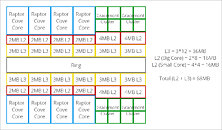Sunday, January 16th 2022

Intel "Raptor Lake" Rumored to Feature Massive Cache Size Increases
Large on-die caches are expected to be a major contributor to IPC and gaming performance. The upcoming AMD Ryzen 7 5800X3D processor triples its on-die last-level cache using the 3D Vertical Cache technology, to level up to Intel's "Alder Lake-S" processors in gaming, while using the existing "Zen 3" IP. Intel realizes this, and is planning a massive increase in on-die cache sizes, although spread across the cache hierarchy. The next-generation "Raptor Lake-S" desktop processor the company plans to launch in the second half of 2022 is rumored to feature 68 MB of "total cache" (that's AMD lingo for L2 + L3 caches), according to a highly plausible theory by PC enthusiast OneRaichu on Twitter, and illustrated by Olrak29_.
The "Raptor Lake-S" silicon is expected to feature eight "Raptor Cove" P-cores, and four "Gracemont" E-core clusters (each cluster amounts to four cores). The "Raptor Cove" core is expected to feature 2 MB of dedicated L2 cache, an increase over the 1.25 MB L2 cache per "Golden Cove" P-core of "Alder Lake-S." In a "Gracemont" E-core cluster, four CPU cores share an L2 cache. Intel is looking to double this E-core cluster L2 cache size from 2 MB per cluster on "Alder Lake," to 4 MB per cluster. The shared L3 cache increases from 30 MB on "Alder Lake-S" (C0 silicon), to 36 MB on "Raptor Lake-S." The L2 + L3 caches hence add up to 68 MB. All eyes are now on "Zen 4," and whether AMD gives the L2 caches an increase from the 512 KB per-core size that it's consistently maintained since the first "Zen."
Sources:
OneRaichu (Twitter), Olrack (Twitter), HotHardware
The "Raptor Lake-S" silicon is expected to feature eight "Raptor Cove" P-cores, and four "Gracemont" E-core clusters (each cluster amounts to four cores). The "Raptor Cove" core is expected to feature 2 MB of dedicated L2 cache, an increase over the 1.25 MB L2 cache per "Golden Cove" P-core of "Alder Lake-S." In a "Gracemont" E-core cluster, four CPU cores share an L2 cache. Intel is looking to double this E-core cluster L2 cache size from 2 MB per cluster on "Alder Lake," to 4 MB per cluster. The shared L3 cache increases from 30 MB on "Alder Lake-S" (C0 silicon), to 36 MB on "Raptor Lake-S." The L2 + L3 caches hence add up to 68 MB. All eyes are now on "Zen 4," and whether AMD gives the L2 caches an increase from the 512 KB per-core size that it's consistently maintained since the first "Zen."

66 Comments on Intel "Raptor Lake" Rumored to Feature Massive Cache Size Increases
Anyway, Intel PR department should've pressed for 69MB total...
Edit: since the sum only counts L2 and L3, and Alder Lake has 1408KB of total L1 cache in 8P+8E config, it might be "rounded" to 69MB ;)
Adding up the total L2 cache is just PR nonsense.
Not while both companies have shills harping about how cache isn’t the new IPC increase they have dreamed about.
Cache is the new IPC tool, the benefit to consumers overall is cache power management rolling off to system ram, Vmem, and allowing for better utilization of power for a given performance product.
Intel should release the 1337K double 69 cache CPU with 6.9Ghz single core with no AVX or Blu-ray decoding or GPU for maximum power to the cores.
And Zen 4 is doubling L2 cache as well as whatever they might do with L3 cache.
The time table for Raptor pond is a good deal away, so this PR 'leak' matters much yet.
Fwiw, that would be a ZX Spectrum clone, didn't even a FDD drive.
Coders nowadays - Helmp! Javascript throws NaN whem I add 1 and 1...
Back on topic time maybe.